The hard facts on marine hardware and components
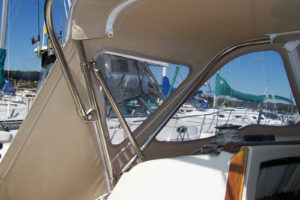 While it may seem like a proportionally small detail for an overall marine fabrication project, finding the best hardware can significantly prolong the lifespan of an end product and tailor it to a specific customer’s needs. The technology for marine hardware is always changing, and it can be hard to keep up with the new products in the gap between trade shows. We caught up with a few of the nation’s most successful manufacturers and distributors to find out what’s hot this summer, and what fabricators can do to stay in the loop on the latest hardware products available.
While it may seem like a proportionally small detail for an overall marine fabrication project, finding the best hardware can significantly prolong the lifespan of an end product and tailor it to a specific customer’s needs. The technology for marine hardware is always changing, and it can be hard to keep up with the new products in the gap between trade shows. We caught up with a few of the nation’s most successful manufacturers and distributors to find out what’s hot this summer, and what fabricators can do to stay in the loop on the latest hardware products available.
The development cycle
Manufacturers insist that input from marine fabricators, regardless of the size of the shop they run, is key to developing new and more technologically advanced hardware. However, the process for developing a new item can take upwards of three years.
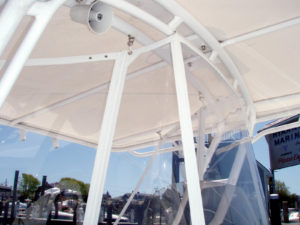
Because of the lengthy testing period, some of the marine hardware just entering the market now are products that have been around for a year or more. Manufacturers say that should help fabricators feel confident that these new products are road-tested and trade-show approved.
“It’s an industry which, because it makes its money in a six-month period, is loathe to change,” says Tom Koster of Tri Vantage. “Because if you make a change and that change fails, then you’ve lost a year’s production. So things have to be very well proven before people will change the way they do things.”
Koster says that even products that have been on the market for five years are still considered “new” by many, as some distributors will wait to see if there is demand before taking care to have a certain item in stock. He says most of the new products are offered as samples at trade shows, which manufacturers use as a testing ground for new ideas.
“Products tend to have a three-year introductory cycle,” he says. “There’s the first time everybody sees it. Then they come back to the convention and say, ‘I tried it out, and this doesn’t work, but this does.’ Or, ‘Yeah, I did that, that and that, but no matter what happens, it ends up failing in this way.’ And then the third time they get together, how a new product is used and its benefits are pretty well established, and then at that point it’s decided that it’s a good idea—or not a good idea, depending on how it worked.”
What’s hot
Because of the lengthy testing period, some of the marine hardware just entering the market now are products that have been around for a year or more—but manufacturers say that should help fabricators feel confident that these “hot” new products are road-tested and trade-show approved.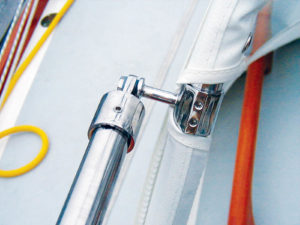
Alan Butcher of Intermold says his company is seeing rising popularity in two of its more versatile products: a new Lever Lock Joiner that securely fastens the telescoping support poles of an awning without having to use screws, and a universal deck hinge that can adapt to a wide variety of boat decks.
“There’s a whole bunch of deck hinge combinations out there, which is one reason we made the universal deck hinge,” Butcher says. “It swivels, and it fits a lot of different deck combinations, so the customer doesn’t have to have the exact angle. In the past they’ve had to slip wedges under them to change the angle of a hinge, because every deck has a little bit different camber to it. So we added a universal hinge that will adjust to whatever deck you put it on, and many customers have found that to be to their advantage.”
Tom Koster also emphasizes the importance of being able to offer versatile hardware. He says that one of his most popular new products is a ball and socket fitting, which can help a fabricator to fit a frame around the curved edges and adapt to new kinds of boats.
“Boats used to be more or less a lot of right angles, or straight angles, but now boats are manufactured with compound curves,” Koster says. “So when you put a frame down, it isn’t a straight line, because the boat itself is curved, the fittings have to be flexible, and allow movement within the hinge itself.”
The newest product we found has only been in development for 18 months, and is just being placed on the market for the first time: YKK’s new adhesive snap fastener, called the Snad. Rod Helwig of YKK says that the Snad was developed as a response to fabricators’ concerns about traditional snap applications.
“To put it frankly, snaps are a pain,” laughs Helwig. “They have to be replaced every couple years, they corrode, they create the holes which can seep, if you’ve ever stepped on one at night you know it’s painful—so there’s a lot of reasons why people wanted to kind of eliminate those applications.”
Rather than drill a hole into the boat’s deck to install a screw stud, YKK’s Snad attaches to the surface of the boat with an adhesive, cutting down installation time and creating a leak-proof solution to snaps. “We’re using a plastic snap so it won’t get hot, it’s shaped as a dome so that if you walked on it, it won’t hurt, it doesn’t create a hole,” Helwig says. “The marine fabricators have been tremendously enthusiastic about it.”
Gemini Products, a newer hardware developer that spouted out of an existing marine fabrication shop, has a few innovative products that have been selling well in both the United States and Canada. Gemini has developed a folding strut, which sales representative Pete Lindquist says can be “used as ‘pusher bars,’ where the dodger frame is pushed back and tensioned, but easily folded—slide the sleeve out of the way and the strut simply folds,” he says. “The strut is not in the way of the folding frame due to the stand-off side mounts.”
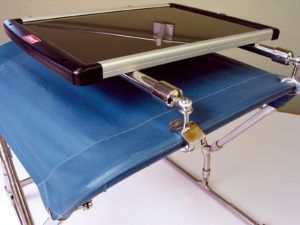
Gemini side mounts are versatile and are offered in many sizes. “One of the uses we are marketing these side mounts for came directly from consumer inventiveness: the attachment of solar panels on existing bimini tops,” explains Peter Lindquist, sales manager for Gemini Products.
Lindquist says his company has also found popularity with its diverse line of side mounts. “Especially important are the 4-inch size,” he says, “making our offering complete for a wide variety of marine frames: 7/8 inch, 1 inch, and 4 inch. Gemini Side mounts are a good solution to that retro-fit project.”
Another company marketing new marine hardware is BoatVent.com, who advertises itself as a supplier of “a new generation marine products.” The company recently added an adjustable model of boat ventilation to its line of products, which ensures that canvas covers stay taut and dry with minimal effort. Its website says that its Adjust-a-vent product will exhaust warm, moist air the same way as Boat Vent II, with the added convenience of allowing covers to be raised and lowered from outside the boat. This eliminates the need for crawling underneath the cover every time cover tension adjustment is needed. To ensure a long and trouble-free life, the hardware is made of stainless steel components.
As with Intermold, BoatVent also offers telescoping cam lock support poles, an innovation that is being seen across the market.
What’s next
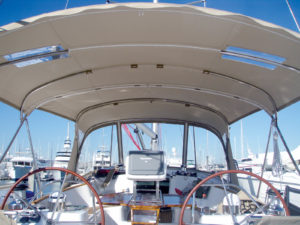
“Boats used to be a lot of right angles, but now boats are manufactured with compound curves,” says Tom Koster of Tri Vantage. “So when you put a frame down, it isn’t a straight line, because the boat itself is curved. The fittings have to be flexible and allow movement within the hinge itself.”
The distributors and manufacturers we talked to emphasized the same key points: Communication is key, and they rely on fabricators to tell them what works and what doesn’t. Not only will manufacturers bring their new ideas to trade shows to run them past fabricators, but they take fabricators’ ideas into account when developing new products.
“It actually goes in both directions,” says Tom Koster. “A manufacturer comes out with something that’s new and he will go to an original equipment manufacturer and eventually test it on a group of fabricators. The flip side of that is, some fabricator in Norwalk, Ohio, or Riviera Beach, Fla., or San Diego will come up with a new and innovative way of doing something, and a manufacturer will see what a good idea that is and they’ll adopt those practices.
Distributors agree that new improvements in hardware are only influential if a significant amount of fabricators are going to buy the product—which means even the most advanced hardware technology could begin and end in a fabrication shop near you.
Andrea Swensson is a freelance writer and editor from Minneapolis.
Care and maintenance of hardware and components
- For most components (stainless steel or nylon hinges, slides, and eye ends) professionals recommend using mild soap and water to clean at the same time as you clean your boat.
- For canvas awnings and seat cushions, take care to use mild soap if sewn with a polyester or cotton thread.
- For canvas awnings and seat cushions sewn with PTFE thread, harsher cleaning chemicals, like bleach, are safe.
 TEXTILES.ORG
TEXTILES.ORG 






